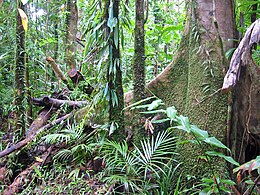Wet Tropics of Queensland
| UNESCO World Heritage Site | |
|---|---|
 Forest near Daintree. Queensland | |
| Location | Queensland, Australia |
| Includes | components:
|
| Criteria | Natural: (vii), (viii), (ix), (x) |
| Reference | 486 |
| Inscription | 1988 (12th Session) |
| Area | 893,453 ha (3,449.64 sq mi) |
| Coordinates | 15°39′S 144°58′E / 15.650°S 144.967°E |
Components in Queensland | |
The Wet Tropics of Queensland is a UNESCO World Heritage Site which has the oldest continuously surviving tropical rainforests on Earth.[1] The forests date from the Mesozoic era when the climate of Australia (and the world) was much more tropical than today. Originally, the rain forest area covered a much wider area than today. Today it is just a narrow strip along the east coast of Queensland. It starts just north of Townsville and continues to just south of Cooktown, a distance of about 450 km (280 mi).
The wet tropics cover an area of 894,420 ha (2,210,160 acres) in 730 separate blocks of land.[2] It includes 41 national parks covering185,000 ha (457,145 acres).[3] About 80% of the site is tropical rainforest. It is interesting because it is very old forest, and is a living record of 415 million years of evolution, going back to Pangea and Gondwana. All of Australia's marsupials, and many of its other animals, evolved in tropical rainforests, and many of their closest surviving ancestors still live in the Wet Tropics of Queensland.
Related pages[change | change source]
References[change | change source]
- ↑ "World Heritage Values". Website Tropics Management Authority. Retrieved 25 May 2019.
- ↑ "Wet Tropics Management Authority - Managing a World Heritage Area". wettropics.gov.au. 2012. Archived from the original on 18 April 2012. Retrieved 22 April 2012.
- ↑ "Wet Tropics of Queensland - UNESCO World Heritage Centre". whc.unesco.org. 2012. Retrieved 22 April 2012.
Other websites[change | change source]
- "Wet Tropics of Queensland - UNESCO World Heritage Centre". whc.unesco.org. 2012. Retrieved 22 April 2012.


